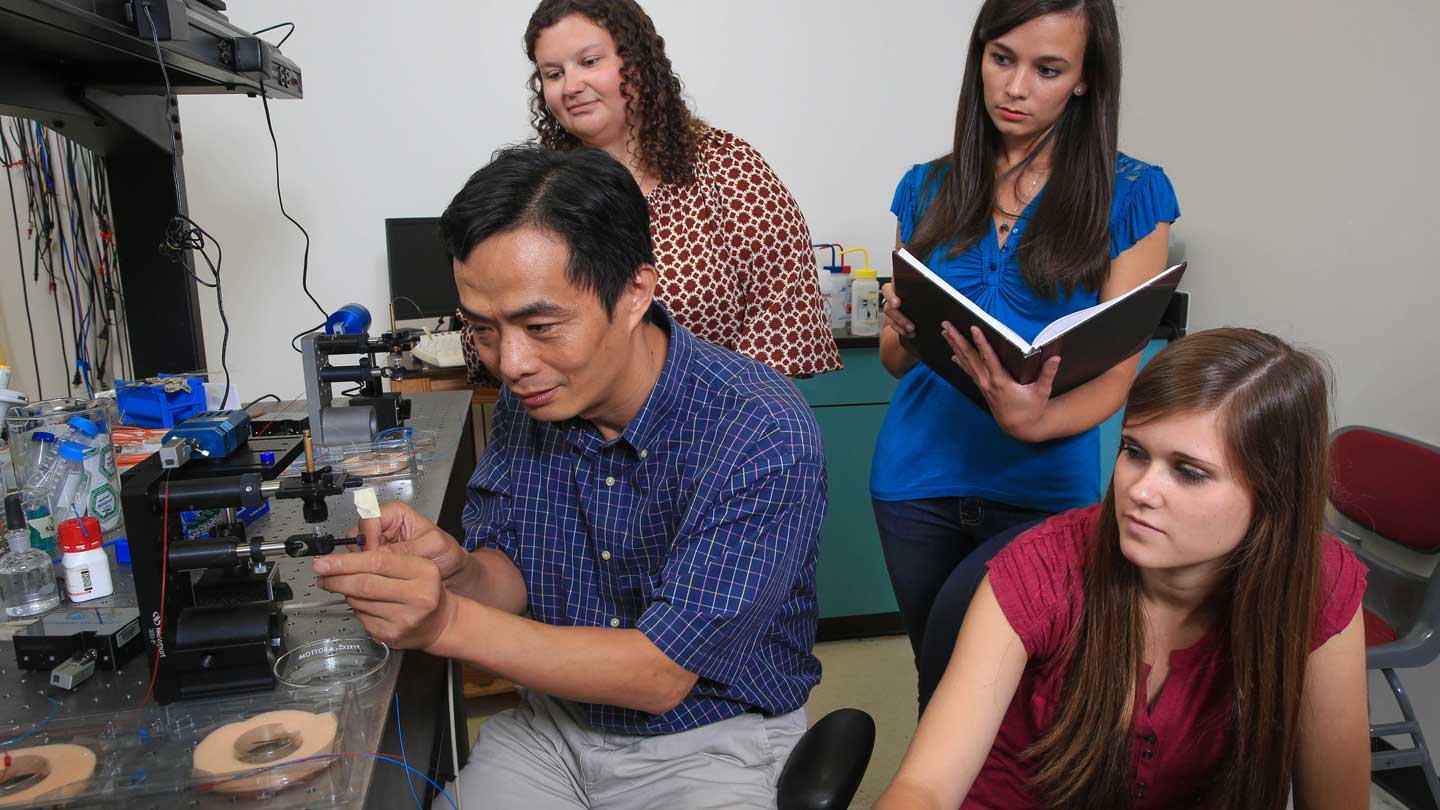
From left, Taylor Bono, Dr. Yongbin Lin, Mollye Sanders and Savannah Kaye discuss the supersensitive nanoprobe sensor they have been developing in a lab in UAH's Optics Building.
Michael Mercier | UAH
A former undergraduate student who is now in a master's program at The University of Alabama in Huntsville (UAH) was the lead author on a journal article
that is one of ScienceDirect's 10 most downloaded chemistry articles among U.S. authors published since January 2014.
Mollye Sanders, who graduated in May and is currently pursuing a master's degree in biology under Dr. Luciano Matzkin, as an undergraduate led the paper
entitled "An enhanced LSPR fiber-optic nanoprobe for ultrasensitive detection of protein biomarkers."
The paper detailed efforts by a UAH team in collaboration with The Joint School of Nanoscience and Nanoengineering (JSNN) in Greensboro, N.C., to develop a
supersensitive nanodevice that can detect cancers and other diseases at an extremely early stage.
Coauthors are UAH's Dr. Yongbin Lin of UAH, Dr. Jianjun Wei of JSNN, former UAH undergraduate student Taylor Bono and UAH's Dr. Robert Lindquist. Bono
graduated from UAH in May with a bachelor's degree in biology and is studying to become a medical doctor at the University of Alabama at Birmingham (UAB).
"I was really shocked and happy to hear the paper was so highly viewed. I knew it was a really interesting project, but I never expected the first
publication I was a part of to become so popular," says Sanders.
Our paper is highly sought because there is a great need for a compact, portable, low-cost, sensitive and user-friendly biosensing platform suitable for a wide spectrum of applications, including personal healthcare, environmental monitoring, food safety and quality assessment, and personal and homeland security.
"The paper was about initial tests in the development of a highly sensitive nano-biosensor, capable of detecting extremely low concentrations of a cancer
protein biomarker, free prostate specific antigen (f-PSA), in the test solution," she says. "Results indicated progress towards a small, point of care
device that could be highly useful in detecting cancer biomarkers in the earliest stages of the disease."
The sensitivity of the device the team created holds promise for finding cancer at a very early stage, even while it is at the small cluster of cells
level, says Dr. Lin. A cancer test the researchers also developed detects minute levels of Interleukin-6 (IL-6) in the test solution. IL-6 is secreted by
the body's T-cells and macrophages to stimulate inflammatory and immune responses and is a marker for cancer. The device can be calibrated to test for any
protein antigen biomarker.
"Our paper is highly sought because there is a great need for a compact, portable, low-cost, sensitive and user-friendly biosensing platform suitable for a
wide spectrum of applications, including personal healthcare, environmental monitoring, food safety and quality assessment, and personal and homeland
security - all to enhance the quality of life," Dr. Lin says. "Mollye and her coworkers have done a great job in developing the biochemistry process in the
Center for Applied Optics lab."
A nanoprobe that's 125 microns in diameter with gold nanodots on a 4-micron fiber core is at the heart of the machine. Current efforts involve
miniaturizing the device for portability and mass-producing the nanoprobe.
"We are currently working on a project to mass fabricate the fiber nanoprobe with high throughput and low-cost using a nano imprint lithography (NIL)
method," says Dr. Lin.
"UAH gives its undergraduate students many opportunities to participate in beyond the classroom experiences," says Dr. Christine Curtis, provost and
executive vice president for academic affairs.
"One of the most important of these is the opportunity to engage in undergraduate research working with faculty in many different disciplines including
engineering, science, nursing, education, business, and arts, humanities and the social sciences," Dr. Curtis says. "Undergraduate research affords
students the opportunity to apply the knowledge they learn in the classroom to important research questions and to learn through actual experience both the
challenges and the joy of discovering new knowledge."